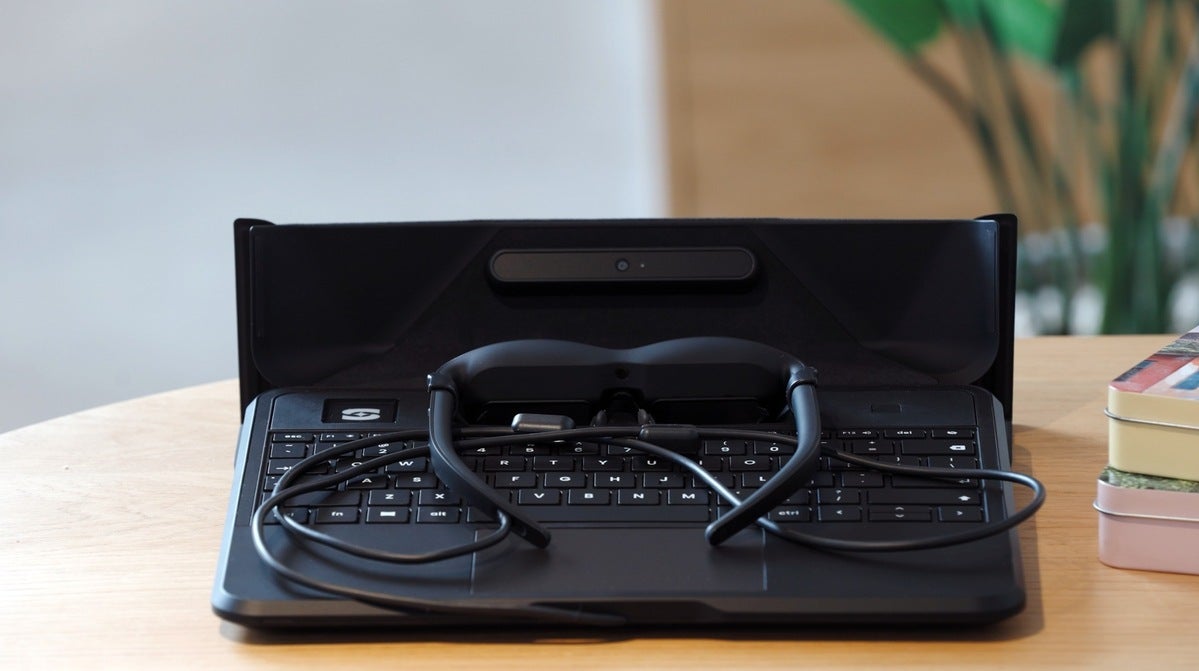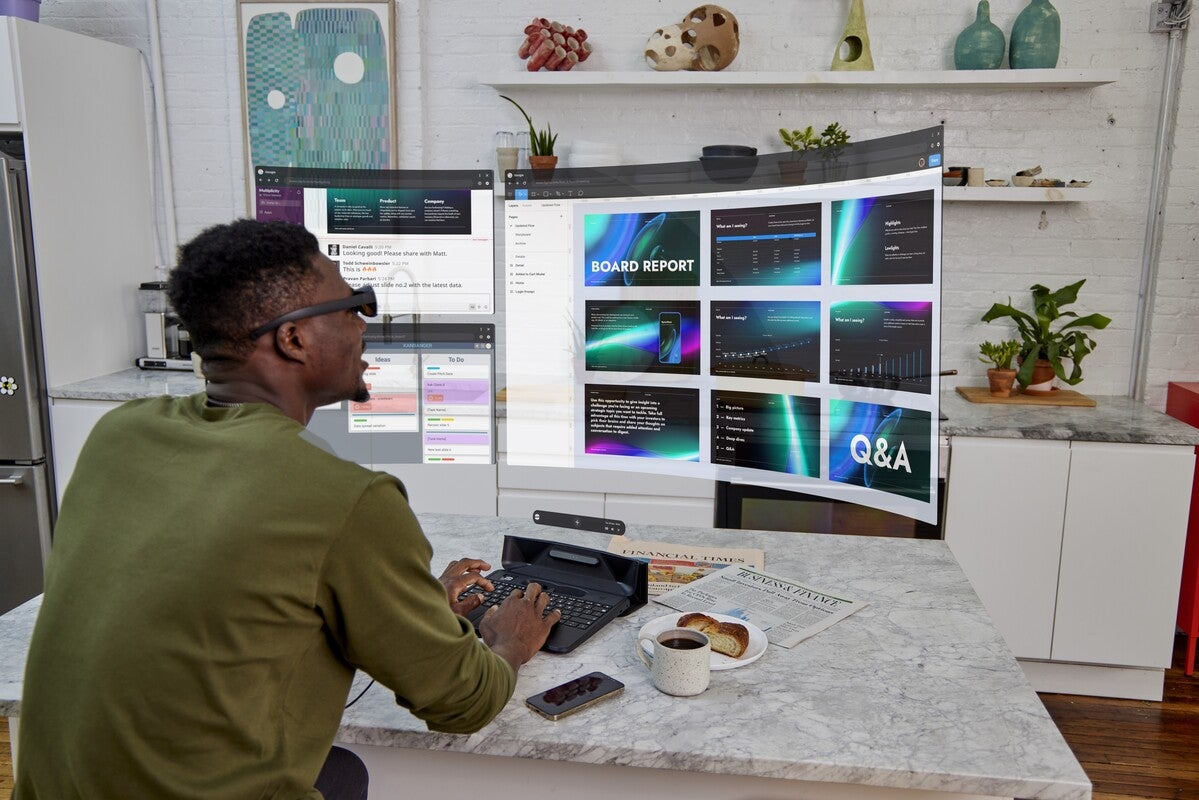Who wants a regular laptop with a 100-in. screen?
The augmented reality PC is finally here. Though the PC is real, the display is virtual — even Apple might make one!
Here comes an entirely new kind of computer.
Events like this don’t happen often. So, we should all stop and marvel at the emergence of what I call the ARPC — the “augmented reality PC.”
The “form factor” solves the decades-old desire to maximize screen size while minimizing hardware size.
And it’s ideal for the age of remote work, digital nomad living, workcations, bleisure travel, staybaticals, hot-desking, hoteling, and every other future-of-work neologism that has emerged since the Covid plague.
Here’s the concept: You have a regular computer but with no physical display. Instead, you wear augmented reality glasses, and the display is virtual. That means you can have a display that’s gigantic with a computer that can be the size of an ordinary laptop.
This kind of PC will probably become very common in the future. It’s actually possible to buy one today. And Apple, of all companies, may offer one soon. Here’s what you need to know.
The fictional ARPC
Virtual reality and augmented reality PCs have been around for decades in fiction. Ernest Cline’s Ready Player One imagined students putting on VR goggles, entering into a virtual world, and in that world, sitting at desks in front of screen. Iron Man had all kinds of holographic displays that floated in air.
(When rolling out his “metaverse” initiative, Meta CEO Mark Zuckerberg suggested that instead of going to an office, we’d all just strap on goggles and go to a VR office where everything is virtual, including the computer.)
While the fantasy has been around for decades, the reality has been around for less than a month.
The rise of the ARPC
A company called Sightful (an Israeli startup formerly known as Multinarity) recently released its Spacetop device, which it categorizes as an “AR laptop.” The physical hardware is about the size and weight of a laptop. The virtual display is a 100-in. screen.
The device was designed by engineers poached from Apple, Microsoft, and Magic Leap. (CEO Amir Berliner and COO Tomer Kahan both worked at Magic Leap.)
Sightful’s AR device
Wistron makes the guts of the computer, Nreal supplies the glasses, and Sightful designed the spacial environment, which it calls “Canvas.”
Anyone watching the company’s concept video will understand the value immediately.
Sightful’s published photos feature nomads, including a woman living the #vanlife lifestyle, and somebody using a giant virtual screen on a sailboat. They also imagine people using the Spacetop from home offices and regular offices.
Anyone can apply to purchase one of 1,000 units, which are for sale at $2,000 each. The company will choose which “enthusiastic early adopters” get to buy one. Anyone who wears prescription glasses can get the headsets customized to their prescription at no charge. The units will ship in July, according to the company.
The hardware and software choices are good. It’s more like a Chromebook, and you live in a browser operating system called the Spacetop OS, which should enable the use of any cloud-based online apps and services. (It’s got a DisplayPort, so you can plug in an actual monitor if you want.) Otherwise, it’s a standard laptop-like device with USB-C ports, Wi-Fi, Bluetooth and even a 5-megapixel camera for video calls. It’s got 8GB of memory and 256GB of storage. And it’s got a battery that should last around five hours.
Sightful’s AR device shows virtual apps viewed through glasses made by Nreal.
Even Apple may be virtually ready to ship an ARPC
Lost in the mountains of rumors, leaks, speculation, concept illustrations, and guesstimates is that Apple is working on a virtual display as part of its Reality Pro product. On June 5, Apple is expected to announce virtual reality goggles that are optimized for augmented reality (AR), meaning virtual objects are superimposed on real-time pass-through video, creating the illusion of AR.
Bloomberg reporter Mark Gurman reported that Apple is working on an ARPC concept as part of its development of the Reality Pro platform. Gurman wrote:
“The device will also have productivity features, including the ability to serve as an external monitor for a Mac. With that feature, users will be able to see their Mac ’ s display in virtual reality but still control the computer with their trackpad or mouse and physical keyboard.”
This is the second rumored feature for Apple Reality Pro that I’ve speculated about that would be revolutionary for enterprises. The first is the “ Bionic Virtual Meeting Room” — AR-based meetings in which participants are represented as Memoji-style holographic avatars — which will probably be unveiled at some point but will probably not use the “bionic” branding.
It would make more sense to release the ARPC feature sooner than it would holographic avatar meeting tech. The reason is twofold. First, developers could take advantage of a giant virtual display right away. Developers love big displays, and they love living as digital nomads.
Second, any AR meeting feature would be maximally beneficial when everyone else has the same feature. And it will be a long, long while before a large number of people are using Apple goggles.
Why the ARPC is the device we need right now
If you think of how long it takes for major console game titles to be developed (many years), you can imagine how long it will take VR applications and, to a lesser extent, AR applications to come to market.
Consider the plight of Apple. It launched AR capability in iPhones and iPads many years ago, mainly to give developers a platform to develop on. Now, it’s about to release a very expensive solution that will mainly benefit developers. The ultimate product will be actual AR glasses that look like regular glasses. By the time this product comes to market, the Apple developers will have had 15 years to develop AR apps.
But here’s the thing: Anyone who launches an ARPC has all the apps already on the market. Such devices using existing applications, either desktop or cloud.
By limiting the AR functionality to a single context, companies such as Sightful can lower costs and have excellent functionality with a full suite of apps already on the market.
For example, Magic Leap and Microsoft’s HoloLens required billions of dollars in investment to figure out how to map 3D spaces so they could “anchor” virtual objects to random objects and surfaces in those spaces. But the Spacetop always anchors AR screens to the same place — the back of the Spacetop device. It’s a much easier proposition.
In other words, while AR and VR products and services for the enterprise depend mostly on technologies and applications that still have to be designed and developed at massive cost and take massive amounts of time, ARPC products can be based on existing technologies running existing applications and, as such, require no additional training to use.
And it solves an existing problem: mobile workers who want bigger screens. The ARPC concept makes sense. And the time is right. Expect big AR screens to become a big deal.


